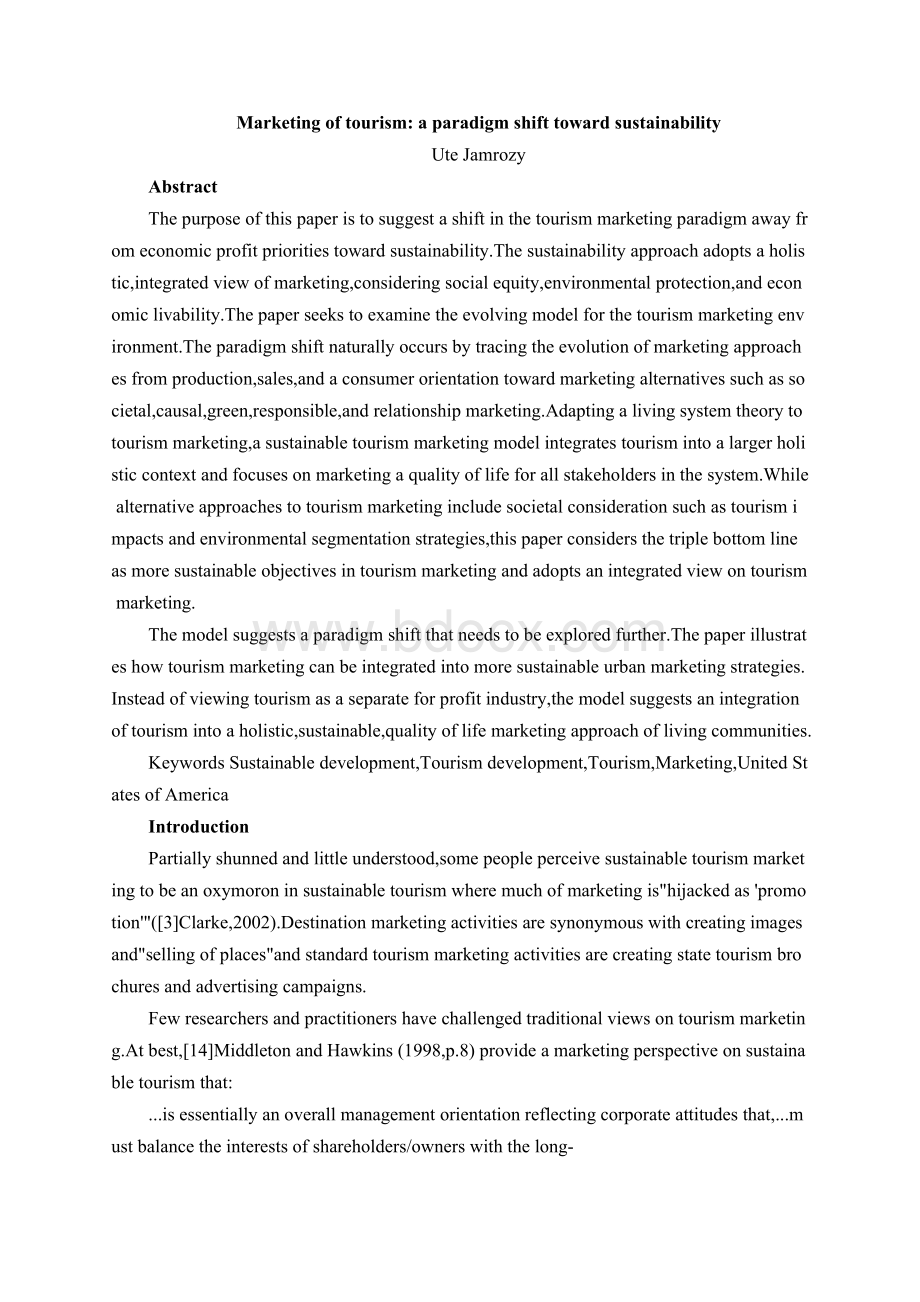旅游市场营销外文文献 (2).docx
《旅游市场营销外文文献 (2).docx》由会员分享,可在线阅读,更多相关《旅游市场营销外文文献 (2).docx(17页珍藏版)》请在冰豆网上搜索。

Marketing of tourism:
a paradigm shift toward sustainability
Ute Jamrozy
Abstract
The purpose of this paper is to suggest a shift in the tourism marketing paradigm away from economic profit priorities toward sustainability.The sustainability approach adopts a holistic,integrated view of marketing,considering social equity,environmental protection,and economic livability.The paper seeks to examine the evolving model for the tourism marketing environment.The paradigm shift naturally occurs by tracing the evolution of marketing approaches from production,sales,and a consumer orientation toward marketing alternatives such as societal,causal,green,responsible,and relationship marketing.Adapting a living system theory to tourism marketing,a sustainable tourism marketing model integrates tourism into a larger holistic context and focuses on marketing a quality of life for all stakeholders in the system.While alternative approaches to tourism marketing include societal consideration such as tourism impacts and environmental segmentation strategies,this paper considers the triple bottom line as more sustainable objectives in tourism marketing and adopts an integrated view on tourism marketing.
The model suggests a paradigm shift that needs to be explored further.The paper illustrates how tourism marketing can be integrated into more sustainable urban marketing strategies.Instead of viewing tourism as a separate for profit industry,the model suggests an integration of tourism into a holistic,sustainable,quality of life marketing approach of living communities.
Keywords Sustainable development,Tourism development,Tourism,Marketing,United States of America
Introduction
Partially shunned and little understood,some people perceive sustainable tourism marketing to be an oxymoron in sustainable tourism where much of marketing is"hijacked as 'promotion'"([3]Clarke,2002).Destination marketing activities are synonymous with creating images and"selling of places"and standard tourism marketing activities are creating state tourism brochures and advertising campaigns.
Few researchers and practitioners have challenged traditional views on tourism marketing.At best,[14]Middleton and Hawkins (1998,p.8) provide a marketing perspective on sustainable tourism that:
...is essentially an overall management orientation reflecting corporate attitudes that,...must balance the interests of shareholders/owners with the long-run environmental interests of a destination and at the same time meet the demands and expectations of customers.
While their approach in analyzing and communicating best practices in tourism is laudable,it stays within the boundaries of the economic marketing paradigm,"balancing"environmental and economic interests,and therefore runs the danger of compromising rather than offering profound alternatives in the discipline of tourism marketing.
This paper examines the evolution of alternative approaches to marketing,suggests a framework for sustainable marketing in tourism,and suggests implications.
This conceptual paper follows the practice of analyzing relevant theories,concepts and practices in the mother discipline of marketing,relating and comparing the research to the tourism marketing domain.During the mid-1980s to the mid-1990s,a small but outspoken research branch explored green and sustainable marketing theory and practices,challenging traditional economic and exchange theories.In tourism,[6]Haywood (1990) and[20]Walle (1998) pioneered critically analyzing the marketing concept in tourism and asked for a"broader and more balanced view of marketing."A"broader"view refers to considering holistic approaches to tourism and developing destination marketing practices accordingly.[20]Walle (1998) suggests examining the philosophical changes within the macro marketing literature and developing more system-based approaches.This paper adopts a living system-based view on tourism and challenges the traditional tourism marketing paradigm by creating a sustainable tourism marketing model (STMM).This model attempts to bring conceptual clarity into a confusing body of language,terminology and alternative approaches to marketing and its use in sustainable tourism.The evolving STMM signifies an elaborated fundamental paradigm shift.This new sustainable marketing paradigm requires an integration of alternative approaches and radically moving towards more sustainable tourism marketing principles and practices.
The evolving sustainable tourism system For decades,researchers have examined tourism as a larger system rather than a simple economic exchange process between businesses and consumers.Planners and economists have established tourism supply (businesses and community resources) and demand (tourist markets) sides,including linkages such as transportation and marketing communications.Marketing directs the flow of products from the producer to the consumer.Expanded models analyze the geographic flows of tourists on t